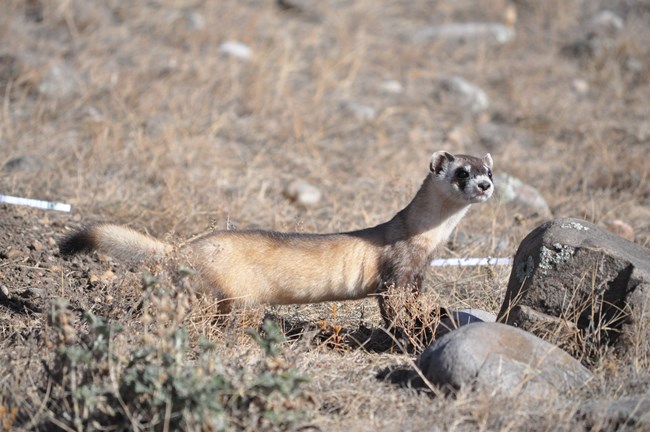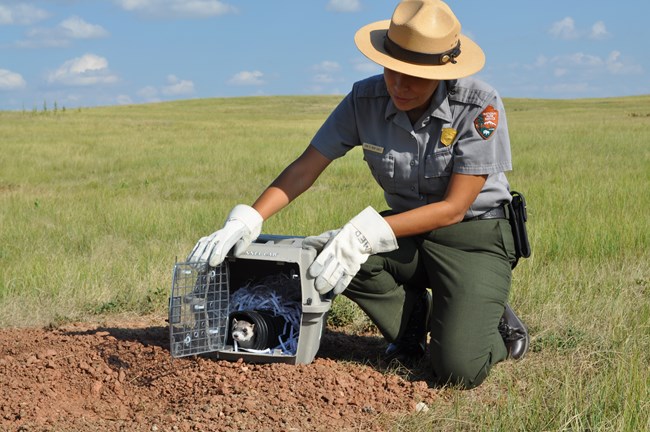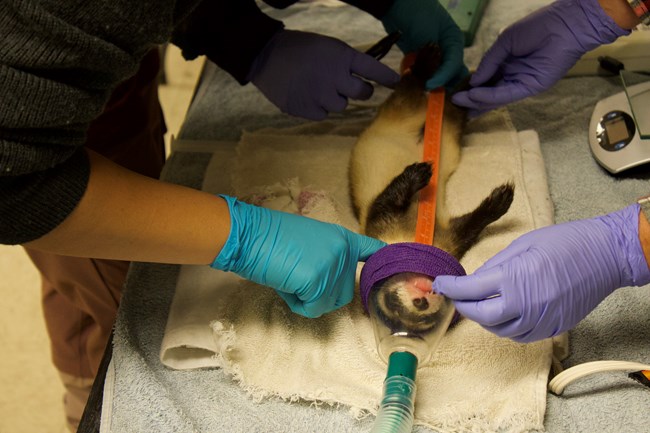Last updated: August 3, 2024
Article
Masked Bandits: Black-footed Ferrets in Wind Cave

NPS Photo
Meet Your New BFF
Rarely does an animal come back from extinction, but the black-footed ferret is one such exception. After being declared extinct in 1979, a rancher’s dog brought a black-footed ferret to its owner and a second chance was born. This animal’s story is a fight for survival.
The black-footed ferret, BFF for short, is a member of the weasel family. From tip of the snout to tail, they are about two feet long. They have a long, slender body with light fur, a “bandit mask” over their eyes, and dark brown or black legs.
The black-footed ferret evolved to depend on the prairie dog and its burrows for food, shelter, and raising its young. The prairie dog makes up 90% of the ferret’s diet and is roughly the same weight as the ferret. That is why ferrets are nocturnal, so they can hunt their prey under the cover of night while the prairie dog sleeps. Black-footed ferrets make their home in prairie dog burrows, living amongst its prey. By keeping a source of food close, and having a warm place to stay, the ferrets can make it through the harsh prairie winters.

NPS Photo
The Decline
The black-footed ferret once inhabited prairie dog colonies that stretched from southern Canada, the central United States, to northern Mexico. As the western American landscape was changed from prairie to cultivation, farmers and ranchers saw the prairie dog as a pest. Approximately 98% of the prairie dog population was poisoned or converted to cropland. With the prairie dog’s dramatic decline, ferret numbers plummeted, and then declared extinct.
In 1981, a small population of ferrets were discovered in Meeteetse, Wyoming by a farm-dog named Shep. From that discovery, 18 ferrets were taken into a captive breeding program launched by the United States Fish and Wildlife Service (USFWS). This program was able to successfully breed ferrets and prepare them for release back to the wild. The first ferrets were reintroduced in 1991 to Shirley Basin in Wyoming and Conata Basin, South Dakota in 1996. Today, state and tribal agencies, private landowners, conservation groups, and North American zoos continue to aid in the survival of the black-footed ferret.

NPS Photo
Reintroduction
Wind Cave National Park was established to protect the cave, but Congress soon realized they needed to protect the land above the cave as well. With the creation of the Wind Cave National Game Preserve in 1912, the park’s mission was expanded to include the restoration of prairie wildlife that had been extirpated from their native range. Bison, elk, and pronghorn were all reintroduced to the park, but a key member of the prairie ecosystem was still missing. With a healthy and abundant prairie dog population, Wind Cave was given a permit by the USFWS to restore the black-footed ferret back to the park.
In 2007, 49 ferrets were released at Wind Cave National Park. Today, the park can support 40-60 black-footed ferrets, depending on annual variation in prairie dog densities.

NPS Photo/Peelee Clark
Disease and Management
The black-footed ferret remains critically endangered. In addition to habitat fragmentation, plague (also known as Bubonic Plague or the Black Death) is now the leading threat to ferret survival. Prairie dogs and ferrets have no immunity to plague—it is a non-native disease that can kill 90% of a prairie dog colony. The problem is plague outbreaks can’t be predicted. The only way to protect prairie dogs and black-footed ferrets from plague is intervention. Deltamethrin dust can be sprayed into burrows to kill fleas which harbor plague, but it is labor intensive and expensive. The park is currently working with United States Geologic Service (USGS) and USFWS to conduct research on new flea control methods that will aid in ferret and prairie dog survival. In addition to research, the park also monitors the health and reproduction of the black-footed ferret.
Each fall, park biologists conduct nighttime ferret surveys to capture ferrets. Staff use spotlights to detect the green eye shine of ferret eyes popping out of a burrow.Traps are set in the prairie dog burrow, and if successful, the captured ferrets are transported to an NPS veterinarian to be examined and vaccinated against plague and canine distemper. Ferrets are also given a microchip with a unique ID that can be used to identify individual ferrets and track them year to year. This allows biologists to monitor the health of the ferret population in the park.
The park continues the legacy of conservation with the black-footed ferret, an animal that exists thanks to its rare second chance at survival. Learn more about how biologists monitor ferret populations in the video below.
-
Black-footed ferret chatter
Black-footed ferrets make a loud chatter to sound an alarm in the presence of danger.
- Credit / Author:
- NPS/Peelee Clark
- Date created:
- 09/20/2023
-
A Night Surveying for Black Footed Ferrets
Twice a year, black-footed ferret surveys are conducted in Wind Cave National Park by a team of employees and volunteers. These rare animals are not only endangered, but also elusive, nocturnal, and fossorial (meaning that they live mostly underground). So how do biologists at the park monitor ferret populations? Watch this video to see just how it’s done!
- Duration:
- 1 minute, 28 seconds

